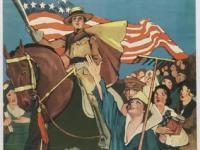In this lesson, students will be introduced to propaganda produced during World War I. Propaganda greatly influenced the home front as well as soldiers’ morale, ranging from recruitment and enlistment ads, to posters asking for wartime loans, to images promoting morale at home. Propaganda influenced the economy during and after WWI, enlistment numbers, recruitment of women’s aid and service organizations, and helped to power the America’s role in the war. This lesson will define propaganda by using primary sources from WWI, outline the influence of propaganda on WWI, and allow students to engage with the primary sources as well as examples of contemporary propaganda through new knowledge.
Introduction to Propaganda in WWI
Introduction to Propaganda in WWI
Essential Questions
Objectives
Students will be able to:
- Understand the early 1900s by analyzing primary source documents depicting propaganda from the WWI and WWII eras.
- Identify and analyze different types of propaganda and their purposes by examining pieces of propaganda from both WWI and today.
- Be able to explain and evaluate their purpose and usage in diverse settings by getting involved in the interactive lecture and classroom discussion.
Primary Sources
Suggested Instructional Procedures
- First, the teacher should present the Propaganda and WWI slideshow as a discussion based interactive lecture using the slideshow for twenty to twenty-five minutes. The lecture starts with discussing propaganda and its seven forms. Give students the guided note-taking hand out. The slideshow handout will be used for the entirety of the lesson.
- In the slideshow, there is a video detailing the seven types of propaganda, and students should be defining the types as the video goes along on their handout. After the video, the class should review the definitions and examples of propaganda that were discussed in the video to ensure that everyone has the correct information.
- Once the definitions are covered, the WWI primary source in the slideshow should be introduced. The teacher should give the students a minute or two to examine the source independently, and then share some of their opinions with the class.
- After analyzing the primary sources independently and as a class, the teacher should introduce a modern example of propaganda. Students should be encouraged to think of their own examples to share with the class too. During this discussion, the teacher should prompt the students to think of the societal effects of propaganda. The students should be able to come up with positive and negative effects, which should lead to a deeper discussion.
- Following this discussion-based lesson, the teacher should assign the students a group assignment. The groups should consist of about three students to ensure there is enough time for students to collaborate. Students should be instructed to analyze three other WWI/ WWII propaganda posters to explain their meaning. Students should identify the type of propaganda being used, analyze the author's intent, and discuss the positive and/ or negative implications of the poster. This should take 10 minutes to complete.
- For the last five minutes of this lesson, the teacher should bring the class back together to discuss the findings of the group assignment. The guided-notes can be collected as an assessment.
Vocabulary
Propaganda: Information, ideas, or rumors deliberately spread widely to help or harm a person, group, movement, institution, nation, etc. It usually appeals to a certain emotion or feeling (fear, pride, embarrassment, happiness)
Name calling/stereotyping: When you invent a name to call someone to help dismiss their credibility.
“Glittering” Generalities: Generalities, virtues, and values.
Testimonial: Personal statement given by a credible person, advocating for the subject of the propaganda regardless of merit or fact.
Transfer or Association: Similar to Testimonial, but reliant on the credibility of an institution rather than an individual.
Bandwagon: Soliciting or advertising based on the desire to be a part of something or to have something in common with the majority (“Everyone’s doing it!” Or, “All the smart people are doing it!”).
Plain Folks: The argument that the “common man” or everyday, wholesome person understands, agrees with, or uses the advertized concept or product.
Professional/”Just a jacket”: Using physical appearance to create the perception of credibility.
Explicit: Fully and clearly expressed or demonstrated; leaving nothing merely implied; unequivocal.
Implicit: Implied rather than expressly stated.
Land Army: A civilian organization that allowed women to work in agriculture to replace the men who are overseas at war.
Bigotry: Stubborn and complete intolerance of any creed, belief, or opinion that differs from one's own.
Primary Source: Pertaining to or being a firsthand account, original data, etc., or based on direct knowledge.
Secondary Source: Pertaining to or being a derived or derivative account, an evaluation of original data, etc.; not primary or original.

Plans in this Unit
Grade Level
Duration
Standards/Eligible Content
PA Core Standards
CC.8.5.6-8B
CC.8.5.6-8H
About the Author
This unit was created by Cultural Fieldwork Initiative Interns from Temple Univeristy Josh Sherman and Schnell Washington, Summer Education Intern Jessica Sharp, and Alicia Parks, Wells Fargo Education Manager at the Historical Society of Pennsylvania.
Attention Teachers!
Let us know how you used this plan and be featured on our site! Submit your story here.

